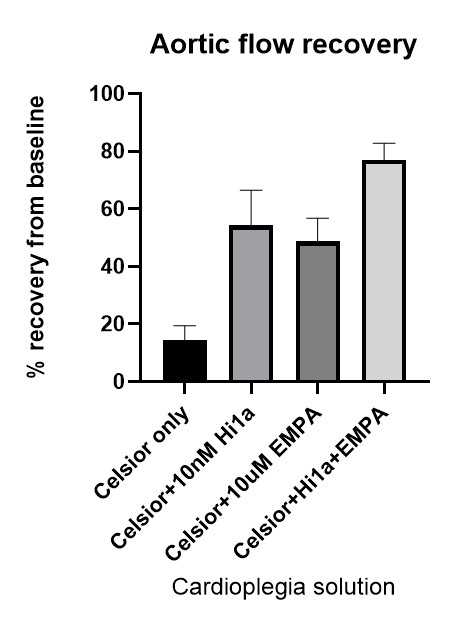Improving donor heart preservation with funnel web spider venom and the anti-diabetic drug empagliflozin
Jeanette Villanueva1, Sanjay Dutta1, Ling Gao1, Aoife Doyle1, Nathan Palpant2, Glenn King2, Peter Macdonald1,3.
1Transplantation Laboratory, Victor Chang Cardiac Research Institute, Sydney, Australia; 2Institute for Biomolecular Science, St Lucia, Australia; 3Heart and Lung Transplant Unit, St Vincent's Hospital, Sydney, Australia
Background: Supplementation of donor heart preservation solutions can improve post-transplant function. Hi1a, an acid-sensing ion channel inhibitor derived from the funnel web spider; and the anti-diabetic drug empagliflozin (EMPA) boosts rodent donor heart functional recovery when used individually. This study aims to test whether combining Hi1a and EMPA together in the heart preservation solution can further improve donor heart preservation.
Method: Male Wistar rat (340-420g;n=4-8) hearts were excised and perfused (KHB, 37°C, Langendorff 10min, Working 15min). Hearts were arrested with Celsior ± 10nM Hi1a, 10µM EMPA, or 10nM Hi1a+10µM EMPA, stored for 6h at 4°C, and reperfused (Langendorff 15min, Working 30min). Aortic flow (AF), coronary flow (CF) and cardiac output (CO) were measured. Cardiac recovery was calculated as a percentage of pre-storage baseline value. Coronary effluent was assessed for lactate dehydrogenase (LDH) release and left ventricle tissue collected for H&E and western blot (phosphorylated-STAT3, p-AMPKα, p-ERK1/2).
Results: Compared to unsupplemented hearts, EMPA-supplementation significantly increased AF recovery (49±8% vs 14±5%, p=0.005) and CO recovery (57±6% vs 36±4%, p=0.01) with similar CF recovery across all groups. Hi1a-supplementation significantly improved AF (54±12%, p=0.005) and CO (62±9%, p=0.01) recovery. Combined EMPA+Hi1a supplementation further increased AF and CO recovery (77±6% and 77±3% respectively, p<0.0001), however increased LDH release was detected after 30mins working reperfusion compared to controls (p=0.03). A trend for reduced contraction bands in Hi1a-supplemented hearts was observed. Compared to unsupplemented hearts, EMPA-supplementation and Hi1a-supplementation increased p-AMPKα phosphorylation however EMPA+Hi1a supplementation reduced p-AMPKα. There were no differences in ERK1/2 and STAT3 phosphorylation between groups.
Conclusion: Donor heart preservation with EMPA+Hi1a improves cardiac functional recovery after prolonged cold storage presenting a novel donor organ preservation strategy.

National Health and Medical Research Council Australia #2000178.
[1] donor heart preservation
[2] ischemia reperfusion injury
